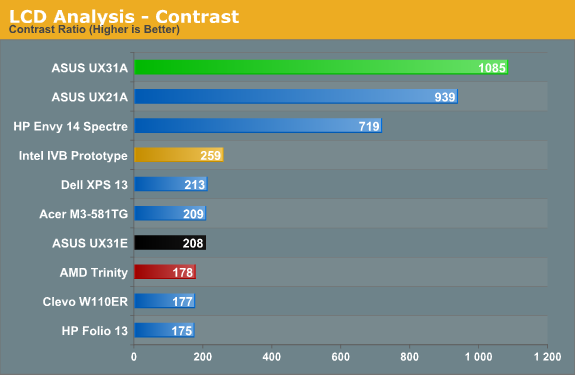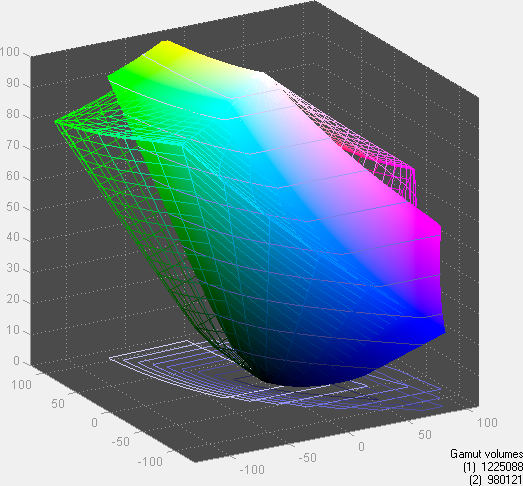ASUS UX31A: Putting the Ultra in Ultrabooks
by Jarred Walton on August 28, 2012 9:00 AM EST- Posted in
- Laptops
- Intel
- Asus
- Ivy Bridge
- Zenbook Prime
- Ultrabook
ASUS UX31A: First Screens First
Normally we save our look at the LCD characteristics for last, but in this case the LCD happens to be one of the highlights of the product. No one else is doing 1080p IPS screens in a 13.3” laptop that I know of (though obviously with the screens available for ASUS we may see some uptake from other manufacturers in the near future), so the UX31A is in a class by itself. We’ve commented on the overall good build quality and keyboard, but it’s the display that really sells the UX31A. Here’s how it stacks up to other Ultrabooks.






Desktop LCDs might still be better for the most part, but contrast ratios above 1000:1 in laptops—with matte displays—are practically unheard of. ASUS tops our contrast ratio chart, but it doesn’t end there. At 400 nits maximum brightness, it’s also one of the brightest LCDs you can find (though not with perfect colors, and post-calibration you’re looking at 300-350 nits, depending on how you calibrate). Obviously battery life will suffer if you run at 100% brightness, but there are occasions (e.g. outside in the sunlight) where it will be necessary and it’s great to have that option. In practice, I was able to use the UX31A—thanks to the matte surface—in a car without trouble with the LCD set to around 200 nits, and I was extremely pleased to not have to look at my reflection for a change (not that I’m ugly, mind, but vanity can only take you so far…).
As for color quality and accuracy, ASUS gives up a bit of ground there compared to some other higher quality LCDs, but dE of less than 2.0 after calibration is good in the laptop world and the color gamut is a respectable 80%. That gamut actually isn’t quite right, though—the gamut is wider than AdobeRGB in some areas but less in others, so if you’re working within the AdobeRGB color space it’s more like 67%. If you’re serious enough about color accuracy that you have the necessary hardware and software for calibrating your laptop, you may not be completely satisfied with the UX31A’s display, but you’ll really have to spend a lot of money to find a better laptop LCD (e.g. the $500+ LCD upgrades found on high-end mobile workstations).
Viewing angles is obviously where IPS can really shine, and while there’s a loss in brightness and contrast at acute angles, there’s no color shifting to worry about. Use it at a desk, on your lap, in an airplane, or wherever else you might find yourself and the UX31A display will still be completely usable. In 2012, this is what we’d like to see from all laptops, but in particular there’s no excuse for $1000+ laptops and notebooks to continue peddling sub-standard TN panels. ASUS gets a well-deserved gold star for their choice of display.
With all the good we have to say about the LCD, we do need to offer one minor word of caution. Windows 7 still doesn’t handle DPI scaling perfectly, and 1080p in 13.3” makes this one of the highest density LCDs around. Windows 8 may improve on the situation, but for those who stick with Windows 7 you’ll still encounter the occasional quirk. ASUS ships with the DPI scaling set to 125% as mentioned earlier, and it’s really necessary if you want most text to be legible. Even with the minor issues with some applications, though, I’d take this sort of display ten times out of ten if given the option.


 Front_thumb.jpg)
 Right_thumb.jpg)
 Left_thumb.jpg)
 Top Minor_thumb.jpg)
 Top Major_thumb.jpg)
 Bottom Minor_thumb.jpg)
_575px.jpg)








106 Comments
View All Comments
JarredWalton - Tuesday, August 28, 2012 - link
I didn't see any stickers, so you should be able to remove the HSF with a bit of effort. I didn't try to do this but the screws are easily accessible. I should note that I tried to disconnect the battery plug and gave up for fear of breaking something, though, so maybe it won't be so easy. LOLj_c - Tuesday, August 28, 2012 - link
"and stay away from the SanDisk U100 if you want decent SSD performance"More details on that particular issue would be nice.
Do you know a way to distinguish between these two models?
JarredWalton - Tuesday, August 28, 2012 - link
AFAIK, ASUS is not shipping the U100 any longer because of the performance issues. You can see where the UX31E and UX21A (with U100) rate in the PCMark 7 Storage suite -- basically the slowest SSD solution we've tested recently. What I don't know is whether ASUS figured out something with the ADATA SF-2281 firmware; I never experienced errors, but the BSOD issue still remains on some laptops/desktops.j_c - Thursday, August 30, 2012 - link
Very interesting, because over here in Germany, it seems the Sandisk model is the only one available. One commenter on amazon.de cites a call by Asus Customer Support, that no ADATA models will be available for now.JarredWalton - Saturday, September 8, 2012 - link
Apparently there are plenty of U100 equipped units shipping; I've updated the conclusion.Shadowmaster625 - Tuesday, August 28, 2012 - link
Can anyone make an educated guesstimate on how much a typical ultrabook would cost if it included this specific display, only a 128GB SSD, 4GB of RAM and the cheapest trinity A8?JarredWalton - Tuesday, August 28, 2012 - link
How much to make or how much it would sell for? In terms of BoM costs, it would probably be around $100 less than the Core i5 version ASUS is selling right now. Retail pricing is the real question. Right now, HP's Sleekbook 6z-1000 sells for $225 less than the Intel i5-3317U variant, but that's also with the A6-4455M which would be substantially slower than full voltage A8. The A10-4655M ought to be reasonably fast in graphics vs. Intel ULV, but we haven't been able to test it and it's $100 more than the A6 version ($125 less than Intel).The big problem is that no one is making 13.3" AMD-based "sleekbooks" that I know of -- links if you have them, please. And in fact, their AMD Sleekbooks are the worst thing I can think of: a 15.6" 1366x768 display with an ultra-thin form factor. Do people want 15.6" thin laptops that much? I feel most people going for ultra-thin are going to want 14" or smaller.
Actually, the biggest problem is getting someone to make a 13.3" AMD laptop with a premium quality LCD. It's possible in theory, but getting the bean counters to agree to spend $100 more or whatever for a "premium" IPS 1080p display while going with a "budget" AMD APU is a very long shot. Heck, getting premium displays in consumer laptops in general is hard enough -- the 1080p UX21A/UX31A/UX32VD are the exception. Others might follow ASUS' lead in the future, but I expect all the quality LCDs to reside in $1000+ laptops for a while yet.
ReverendDC - Tuesday, August 28, 2012 - link
I understand that SSD is faster, but I would like more mention of the dependability or lack therein of SSD. I am not sure of the warranty on this device, but if it is a year, you may have issues, especially if you move large chunks on and off the drive regularly (as you probably would for movies and music when taking the laptop on travels). Most SSDs have a warranty of three years, and even AnandTech has stated that you should expect about 5 years of storage, but anything more is gravy.I have 15 year old spinning platters that still give data, although there are some bad sectors starting to crop up. Obviously, I am not willing to go backwards, but SSD is not the best use case in every scenario, especially if data fidelity is a top requirement, even if it is much speedier. What we really need is a price cut in SLC modules, which are far more reliable, with better capacity.
That being said....thanks for the great review. Informative as always.
JarredWalton - Tuesday, August 28, 2012 - link
SSD durability is still far greater than five years for all but the most strenuous use cases, so I'm not too concerned about that. If you're constantly writing data to SSDs, you can burn through it faster, but Anand did some testing where he calculated even extreme use cases would still last five years. Five years from now, I suspect other areas of the laptop are likely to be failing (fans, hinges, whatever), and when an SSD runs out of cycles you can still read data off of it.Kristian Vättö - Tuesday, August 28, 2012 - link
As we have stated in numerous SSD reviews, the endurance of current MLC NAND is not a problem for consumer use.